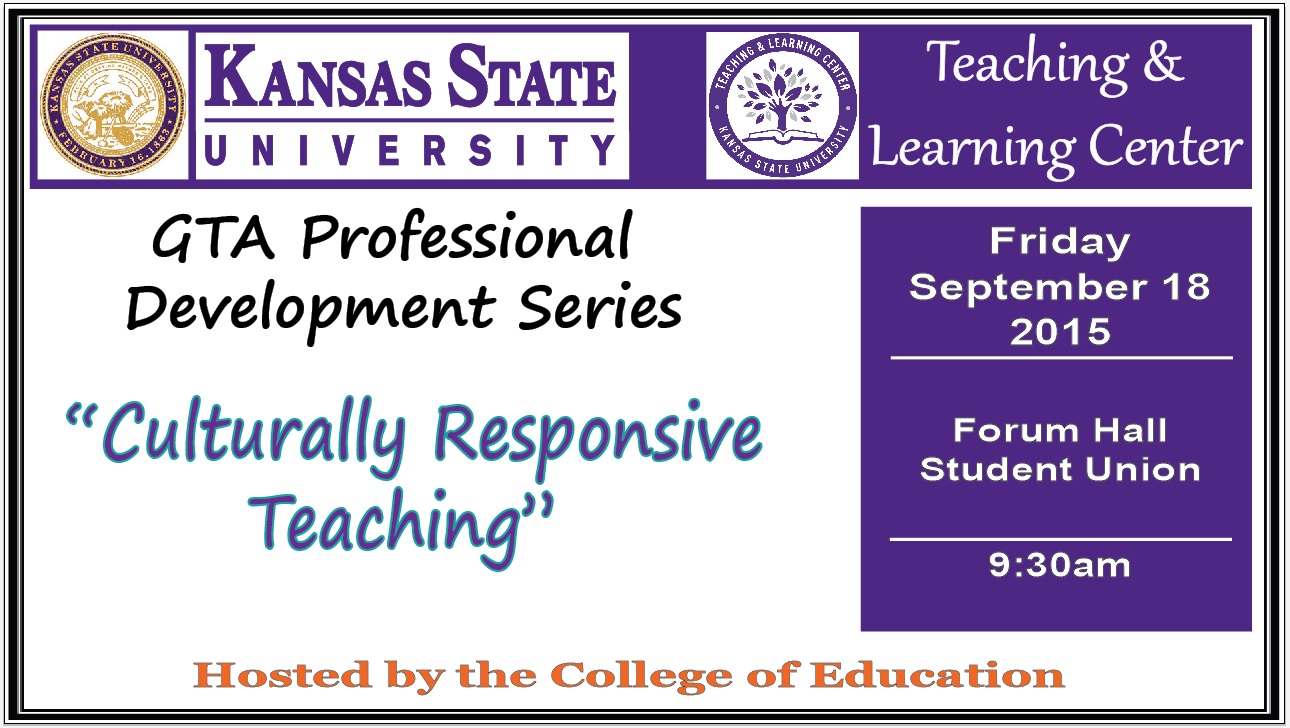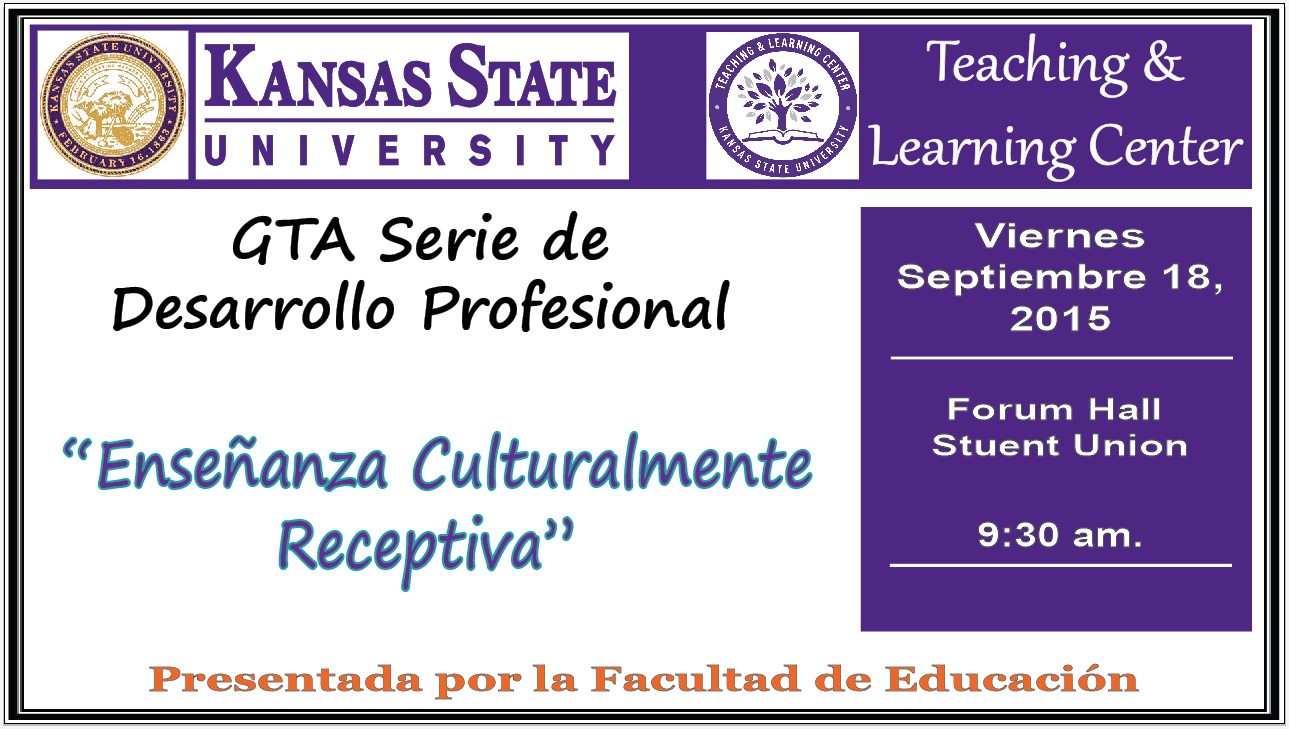Author: Monica E. Vaca-Cárdenas
GTA-PDS. “Culturally Responsive Teaching”
GTA-PDS “Enseñanza Culturalmente Receptiva”
GTA-PDS “Teaching Students to Write Well”
GTA-PDS “Enseñando a los Estudiantes a escribir bien”
GTA – PDS- The Teaching Persona
The Teaching Persona
August 26, 2015
Dr. Jana Fallin Ph.D.
Information from: The 4 Properties of Powerful Teachers by Rob Jenkins published in The Chronicle of Higher Education on April 3, 2015, Volume LSI, Number 29, page A31.
 On our first event of the Fall GTA – Professional Development Series, Dr. Jana Fallin talked about the 4 Ps that the persona who is teaching needs to possess and she gave some advices on how to become a great teacher.
On our first event of the Fall GTA – Professional Development Series, Dr. Jana Fallin talked about the 4 Ps that the persona who is teaching needs to possess and she gave some advices on how to become a great teacher.
-
Personality
What are some traits or characteristics that make teachers great?
Great teachers are…
- Good-natured and approachable
- Professional without being aloof
- Funny
- Demanding without being unkind
- Comfortable in their own skin and natural
- Creative and willing to try something new
You do NOT have to emulate all of these traits. One of the best things about teaching is that our profession is idiosyncratic – we are all different, and that’s okay!
Do NOT try to be something that you’re not.
Focus on your positive traits and practice some of these other traits as you see fit.
-
Presence
How can we practice “owning” the room?
Presence is the ability to make students feel at ease in your classroom. Presence is something that we can work on but that takes practice.
You can start practicing by observing other teachers in the classroom. Take notes about things that work well and things that need improvement. Pay special attention to what the STUDENTS are doing as you observe the classroom.
- Practice makes perfect, so try to practice your presentation skills as much as possible – presenting your research in front of your colleagues and/or asking a faculty member if you can guest lecture is a great way to establish your “presence.”
- NEVER just go through the motions. If you are teaching a class for the first time or for the 20th time, make sure you are mindful of your presence.
- Think about videotaping your lectures. It can be painful to watch yourself on video, BUT it can be one of the most helpful ways for you to see how you can improve your presence.
-
Preparation
What does it look when YOU prepare for class?
- You will not always be teaching a subject that you are an “expert in.” As such, preparation is key to being an effective teacher.
- Think of techniques to get students involved with their learning. As you prepare, keep in mind that learning is messy and that is okay. You want to give your students opportunities (e.g., low risk assignments) to take risks and in some cases fail. Failure can be an important learning opportunity.
- When students know that you care about what they think and that you want to help them to succeed, this will motivate them to get more involved with their learning.
- Think about the structure of your class and make sure that you implement this structure and consistency. Structure for your class can be things as simple as showing up early for class each day and/or making details about assignments available ahead of time for students etc. The more your students see you are prepared and want them to succeed, the more likely they are to get involved with their learning.
- Prepare for class by acknowledging that you are NOT the “keeper” of knowledge. Instead you are the “facilitator” of knowledge.
-
Passion
Do you love your subject matter AND your students?
This might be the most powerful and important of all qualities.
- NEVER talk about students in a demeaning and disrespectful way. Sure, there will be times when you get frustrated with your students and you need to vent, but make sure at the end of your venting session you brainstorm solutions to the problem(s).
- If students are coming to class late you can vent about how frustrating that is with a colleague, BUT how might you solve this problem? Maybe talk to the tardy student(s) and/or implement a late policy.
- Constantly complaining without brainstorming solutions to the problems will only create hostility between you and your students – hostility and negativity toward your students ≠ powerful/effective teaching.
GTA- PDS – El Personaje que Enseña
El Personaje que Enseña
Agosto 26, 2015
Dr. Jana Fallin Ph.D.
Información de: The 4 Properties of Powerful Teachers por Rob Jenkins, publicada en The Chronicle of Higher Education el 3 de Abril, 2015, Volumen LSI, Número 29, página A31.
 En nuestro primer evento de la Serie de Desarrollo Profesional para GTAs, la Dra. Jana Fallin, habló de las 4 P que la persona que enseña debe poseer y dio algunos consejos sobre cómo convertirse en un gran maestro.
En nuestro primer evento de la Serie de Desarrollo Profesional para GTAs, la Dra. Jana Fallin, habló de las 4 P que la persona que enseña debe poseer y dio algunos consejos sobre cómo convertirse en un gran maestro.
-
Personalidad
¿Cuáles son algunos rasgos o características que hacen que los maestros sean grandiosos?
– Los buenos maestros son..
- Bondadosos y accesibles
- Profesionales sin ser distantes
- Graciosos
- Exigentes sin ser crueles
- Cómodos en su propia piel y son naturales
- Creativos y dispuestos a intentar algo nuevo.
– Usted NO tiene que emular todos estos rasgos. Una de las mejores cosas de la enseñanza es que nuestra profesión es idiosincrásica, Todos somos diferentes, y eso está bien!.
– NO trate de ser algo que no es.
– Concéntrese en sus rasgos positivos y practique algunos de estos otros rasgos como mejor le parezca.
-
Presencia
¿Cómo podemos practicar el “poseer” el aula?
La presencia es la capacidad de hacer que los estudiantes se sientan a gusto en su salón de clases. La presencia es algo que podemos trabajar, pero que requiere práctica.
- Tome notas sobre las cosas que funcionan bien y las cosas que necesitan mejorar. Preste especial atención a lo que los estudiantes están haciendo mientras observa el salón de clase.
- La práctica hace al maestro, así que trate de practicar sus habilidades de presentación tanto como sea posible – la presentación de su investigación al frente de sus colegas y/o pedirle a un miembro de la facultad si puede participar como invitado en su clase. Esta es una gran manera de establecer su “presencia”
- NUNCA siga solamente los movimientos. Si usted está enseñando una clase por primera vez o por la vigésima vez, asegúrese de que esté consciente de su presencia.
- Piense en la posibilidad de grabar en vídeo sus conferencias. Puede ser doloroso verse a usted mismo en el vídeo, pero puede ser una de las formas más útiles para ver cómo puede mejorar su presencia.
-
Preparación
¿Cómo se nota cuando usted prepara para la clase?
- Usted no siempre estará enseñando una materia en la que usted es un “experto”. Como tal, la preparación es clave para ser un buen maestro.
- Piense en técnicas para lograr que los estudiantes participen en su aprendizaje. Mientras prepara, tenga en mente que el aprendizaje es desordenado y eso está bien. Usted quiere dar a sus estudiantes oportunidades (por ejemplo, tareas de bajo riesgo) tomar riesgos y en algunos casos fracazar. El fracaso puede ser una oportunidad de aprendizaje importante.
- Cuando los estudiantes saben que usted se preocupa por lo que piensan y que usted desea ayudarlos a que tengan éxito, esto los motivará a involucrarse más con su aprendizaje.
- Piense en la estructura de su clase y asegurarse de que se implemente esta estructura y consistencia. La estructura para su clase pueden ser cosas tan simples como llegar temprano a clase cada día y/o dando detalles acerca de las tareas disponibles con tiempo de anticipación para los estudiantes, etc. Cuanto más sus estudiantes vean que usted está preparado y quiere que tengan éxito, es más probable que se involucren con su aprendizaje.
- Prepare para la clase reconociendo que usted no es el “guardián” del conocimiento. En cambio usted es el “facilitador” del conocimiento.
-
Pasión
¿Ama su tema y a sus estudiantes?
- Esta podría ser la más poderosa e importante de todas las cualidades.
- NUNCA hable de los estudiantes de una manera degradante e irrespetuosa . Claro, habrá momentos en los que se sienta frustrado con sus estudiantes y necesite desahogarse, pero asegúrese de que al final de su sesión de ventilación usted aporte ideas de soluciones al problema (s).
- Si los estudiantes vienen a clase tarde, usted puede desahogarse sobre lo frustrante que es eso con un colega, PERO ¿cómo podría resolver este problema? Tal vez hablando con el estudiante(s) que llega tarde y/o poniendo en práctica una política de retraso.
- El quejarse constantemente sin proponer ideas de soluciones a los problemas sólo creará hostilidad entre usted y sus estudiantes. Hostilidad y negatividad hacia sus estudiantes ≠ (no es igual a) una enseñanza efectiva y ponderosa.
GTA – PDS- The Teaching Persona/ El Personaje que Enseña – Pictures/Fotos
On our first event of the Fall GTA – Professional Development Series, Dr. Jana Fallin talked about “The Teaching Persona” article. Here are some pictures from the event.



























































Recent Comments